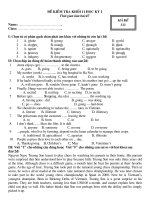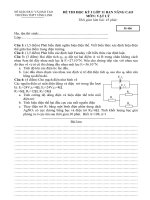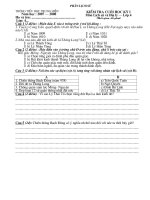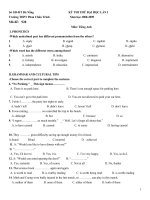prohens - vegetables i (springer, 2008)
Bạn đang xem bản rút gọn của tài liệu. Xem và tải ngay bản đầy đủ của tài liệu tại đây (7.61 MB, 426 trang )
VEGETABLES I
HANDBOOK OF PLANT BREEDING
Editors-in-Chief:
FERNANDO NUEZ, Universidad Politecnica de Valencia, Valencia, Spain
Volume 1
Volume 2
Vegetables II: Fabaceae, Liliaceae, Solanaceae and Umbelliferae
JAIME PROHENS, Universidad Politecnica de Valencia, Valencia, Spain
Edited by Jaime Prohens and Fernando Nuez
Edited by Jaime Prohens and Fernando Nuez
MARCELO J. CARENA, North Dakota State University, Fargo, ND, USA
Vegetables I: Asteraceae, Brassicaceae, Chenopodicaceae, and Cucurbitaceae
and Cucurbitaceae
Universidad Politecnica de Valencia
Valencia, Spain
Valencia, Spain
and
Universidad Politecnica de Valencia
VEGETABLES I
Edited by
Fernando Nuez
Jaime Prohens
Asteraceae, Brassicaceae, Chenopodicaceae,
14 Camino de Vera
Valencia 46022
Spain
Fernando Nuez
COMAV-UPV
Spain
Universidad Politecnica de Valencia
Jaime Prohens
Universidad Politécnica de Valencia
14 Camino de Vera
Valencia 46022
COMAV-UPV
Printed on acid-free paper.
9 8 7 6 5 4 3 2 1
springer.com
similar or dissimilar methodology now known or hereafter developed is forbidden.
to proprietary rights.
permission of the publisher (Springer Science+Business Media, LLC, 233 Spring Street, New York, NY
tion with any form of information storage and retrieval, electronic adaptation, computer software, or by
The use in this publication of trade names, trademarks, service marks, and similar terms, even if they are
not identified as such, is not to be taken as an expression of opinion as to whether or not they are subject
All rights reserved. This work may not be translated or copied in whole or in part without the written
10013, USA), except for brief excerpts in connection with reviews or scholarly analysis. Use in connec-
© 2008 Springer Science+Business Media, LLC
Library of Congress Control Number: 2007936360
ISBN: 978-0-387-72291-7 e-ISBN: 978-0-387-30443-4
Y. Peng)
Cover illustration: A lettuce seed production field near Fresno, California, U.S.A. (courtesy of
Contents
Preface vii
Contributors ix
Family Asteraceae (=Compositae)
and Paolo Parrini
Sergio Lanteri and Ezio Portis
Beiquan Mou
Family Brassicaceae (=Cruciferae)
Amando Ordás and M. Elena Cartea
Ferdinando Branca
Family Chenopodiaceae
Teddy E. Morelock and James C. Correll
Margherita Lucchin, Serena Varotto, Gianni Barcaccia,
1. Chicory and Endive 3
2.
Globe Artichoke and Cardoon 49
3. Lettuce
75
4. Cabbage and Kale 119
5. Cauliflower and Broccoli 151
6. Spinach
189
vi Contents
Irwin L. Goldman and John P. Navazio
Family Cucurbitaceae
Jack E. Staub, Matthew D. Robbins, and Todd C. Wehner
Michel Pitrat
María Ferriol and Belén Picó
Harry S. Paris
Todd C. Wehner
1 2. Watermelon
7. Table Beet 219
8. Cucumber
241
9. Melon
283
10. Pumpkin and Winter Squash 317
11. Summer Squash 351
381
Index 419
Preface
last years, with a global growth in the production of more than 50% in the last
decade, a rate of increase that is much higher than for other plant commodities.
Vegetables constitute an important part of a varied and healthy diet and provide
significant amounts of vitamins, antioxidants and other substances that prevent
diseases and contribute to an improvement in the quality of life. In consequence, it is
expected that in the coming years, vegetable crops production will continue its
expansion.
Improved varieties have had a main role in the increases in yield and quality of
vegetable crops. In this respect, the vegetables seed market is very dynamic and
competitive, and predominant varieties are quickly replaced by new varieties.
Therefore, updated information on the state of the art of the genetic improvement of
specific crops is of interest to vegetable crops breeders, researchers and scholars.
During the last years an immense quantity of new knowledge on the genetic diversity
of vegetables and the utilization of genetic resources, breeding methods and
techniques, and on the development and utilization of modern biotechnologies in
vegetables crop breeding has accumulated, and there is a need of a major reference
work that synthesizes this information. This is our objective.
The diversity of vegetable crops is appalling, with hundreds of species being (or
having been) grown. However, among this plethora of crops, there are some which
are prominent, and for which there has been a greater development in the breeding
science and development of varieties. In consequence, we have produced two
volumes devoted to 20 of these most important vegetable crops. These crops belong
to eight different botanical families. Because in many cases crops from the same
botanical family share many reproductive, physiological, and agronomic features, as
well as similar breeding techniques, we have decide to group them by this taxonomic
category. In this respect, this first volume includes 12 chapters that deal with
vegetables that belong to four families: Asteraceae or Compositae (chicory and endive,
The production and consumption of vegetables has expanded dramatically in the
Preface
viii
globe artichoke and cardoon, and lettuce), Brassicaceae or Cruciferae (cabbage, and
cauliflower and broccoli), Chenopodiaceae (spinach and sugar beet) and Cucurbitaceae
(cucumber, melon, pumpkin and winter squash, summer squash, and watermelon).
Chapters have been written by outstanding breeders with wide experience in the
crop treated. Each chapter includes information on the origin and domestication,
varietal groups, genetic resources, major breeding achievements and current goals of
breeding, breeding methods and techniques, integration of the new biotechnologies
in the breeding programmes, and the production of seed of specific crops.
The completion of this book would not have been possible without the contributions
of the many authors, who have devoted much time to the task of writing the chapters.
We also want to thank the staff of Springer, in particular Jinnie Kim and Shoshana
Sternlicht, who have made possible to produce a high quality book in a very short
time span. We are also indebted to many colleagues for useful suggestions that have
contributed to improve this book.
Fernando Nuez
Valencia, Spain
Jaime Prohens
Contributors
Gianni Barcaccia
Dipartamento di Agronomia Ambientale e Produzioni Vegetali, University of
Padova, 35122 Padova, Italy
Ferdinando Branca
Dipartimento di OrtoFloroArboricultura e Tecnologie Agroalimentari (DOFATA),
Università di Catania, Via Valdisavoia 5, 95123 Catania, Italy
M. Elena Cartea
Misión Biológica de Galicia, Spanish National Research Council, P.O. Box 28,
36080 Pontevedra, Spain
James C. Correll
Department of Plant Pathology, University of Arkansas, Fayetteville, AR 72701,
USA
María Ferriol
Irwin L. Goldman
Department of Horticulture, University of Wisconsin, 1575 Linden Drive, Madison,
WI 53706, USA
Sergio Lanteri
Di.Va.P.R.A., Plant Genetics and Breeding, University of Torino, Via Leonardo da
Vinci 44, 10095 Grugliasco, Italy
Camino de Vera 14, 46022 Valencia, Spain
Institute of Mediterranean Agroforestry, Universidad Politécnica de Valencia,
Contributors
x
Margherita Lucchin
Dipartamento di Agronomia Ambientale e Produzioni Vegetali, University of
Padova, 35122 Padova, Italy
Beiquan Mou
United States Department of Agriculture, Agricultural Research Service, 1636 E.
Alisal St., Salinas, 93905 CA, USA
Teddy E. Morelock
Department of Horticulture, University of Arkansas, Fayetteville, AR 72701, USA
John P. Navazio
Abundant Life Seeds, P.O. Box 157, Saginaw, OR 97472, USA
Amando Ordás
Misión Biológica de Galicia, Spanish National Research Council, P.O. Box 28,
36080 Pontevedra, Spain
Harry S. Paris
Paolo Parrini
Dipartamento di Agronomia Ambientale e Produzioni Vegetali, University of
Padova, 35122 Padova, Italy
Belén Picó
Politécnica de Valencia, Camino de Vera 14, 46022 Valencia, Spain
Michel Pitrat
Unité de Génétique et Amélioration des Fruits et Légumes, Station d’Amélioration
des Plantes Maraîchères, Institut National de la Recherche Agronomique, Domaine
St. Maurice, B.P. 94, 84143 Montfavet, France
Ezio Portis
Di.Va.P.R.A., Plant Genetics and Breeding, University of Torino, Via Leonardo da
Vinci 44, 10095 Grugliasco, Italy
Matthew D. Robbins
USDA, ARS, Department of Horticulture, University of Wisconsin, 1575 Linden
Drive, Madison, WI 53706, USA
Jack E. Staub
USDA, ARS, Department of Horticulture, University of Wisconsin, 1575 Linden
Drive, Madison, WI 53706, USA
Research Organization, P.O. Box 1021, Ramat Yishay 30095, Israel
Department of Vegetable Crops, Newe Ya’ar Research Center, Agricultural
Institute of Conservation and Improvement of Agrodiversity, Universidad
Contributors
xi
Serena Varotto
Dipartamento di Agronomia Ambientale e Produzioni Vegetali, University of
Padova, 35122 Padova, Italy
Todd C. Wehner
Department of Horticultural Science, North Carolina State University, Raleigh, NC
27695-7609, USA
Chicory and Endive
Margherita Lucchin
1
, Serena Varotto
1
, Gianni Barcaccia
1
, and Paolo Parrini
1
1
University of Padova, Dipartimento di Agronomia Ambientale e Produzioni Vegetali,
1 Introduction
Chicory and Endive are common names that correctly indicate two different species.
Their conversational use may nevertheless bring about some misunderstanding as
they do not only refer to a series of different leafy vegetables but, more extensively,
to substantially different crops from which many different products are obtained.
As leafy vegetables, chicory and endive are much less used than lettuce or
cabbages, but they are anyway among the most known and popular horticultural
products in the world and, although with great differences in cultural practices and
type of utilization, they are diffused in almost every country and are included in the
diet of most western as well as eastern populations. Mainly known as important
components for fresh salads, they are also often cooked and differently prepared
according to traditions and alimentary habits.
Chicory and endive are two traditional European horticultural crops and,
although they cannot be considered as autochthonous, their evolution as vegetable
crops has taken place in continental Europe where they have gradually differentiated
in a variety of cultivated types.
Actually, the name “Endive” only indicates a leafy vegetable crop whose
cultivated material usually refers to two groups of cultivars: the “Escarole Group”
and the “Curled Endive Group”. On the other side, the term “Chicory” indicates at
least two kinds of crops: a leafy vegetable, very differentiated according to several
cultural types, and a root crop whose industrial utilization seems at present mainly
addressed to inulin extraction or, on a more limited scale, to the production of a
coffee substitute. Both these types of “root chicory”, have the same origin as they
have been derived from the so called “Magdeburg chicory”, the ancient root chicory
Margherita Lucchin et al.
known and traditionally used in some European countries as a coffee substitute since
the end of 16
th
century and that gained outstanding importance with the continental
block at the time of Napoleon. Also a very important leafy vegetable, the so called
“Witloof chicory” or “Belgian endive”, perhaps the most known among the leafy
chicories, has to be considered a derivative of the Magdeburg chicory as it seems
commonly accepted that its first well known pale yellowish sprouts have casually
been obtained by a Belgian farmer who, around 1870, had observed and harvested
them from a stock of roots piled up in autumn and left apart during the cold season,
waiting to be dried, grounded, and toasted.
Lacking comprehensive, homogeneous, sufficiently detailed, and univocal data
on horticultural productions and trade, it is impossible to give reliable figures on the
diffusion and economic importance of the two cultures in Europe, where chicory and
endive are mostly grown.
In the most recent statistics concerning the European market (EU Market Survey
2004 for fresh fruit and vegetables) too, chicory and endive are often confused under
the general voice “salads”, or considered together with lettuce which is by far the
most important leafy vegetable at both European and world-wide scale. The situation
is not very different if one considers, as a source of reliable information, the statistics
of each single country. On the basis of accessible data it is however possible to
figure out that Belgium, France, Italy, and Netherlands are the almost exclusive
producers of chicory and endive. These two crops do not give a great contribution to
each country’s total agricultural income, but they are very important at local level, as
they characterize the agriculture of limited areas where from 80 to 90% of the
country’s production is concentrated. This is the case of France, where 86% of the
more than 15.000 ha of Witloof chicory grown in the country are localized in four
northern departments, or of Italy, where the north eastern region accounts for 87% of
the national acreage and 84% of the national production of that particular type of red
or variegated chicory known as “Radicchio”. The Escarole and Curly endive types,
in both France and Italy, are much less concentrated and may extend far south where
they are usually grown. The same occurs with other chicory types like the “Chicory
of Catalogne”. By the way, regarding the possible confusion between the two terms,
it may be interesting to note that the Witloof chicory is officially registered by
French statistics as “Endive”, while the Escarole and the Curly endive are identified
as “Chicorèe”.
Furthermore, it is perhaps worth noting that chicory and endive are not only
important for the local economies, but they may have significance at an international
trade scale too. Altogether, the US imports of chicory in 2002 have been equal to
5996 Mt for a value of $ 8.193.000. About a half of these amounts, both in quantity
and value, are represented by Witloof chicory, whose imports from Belgium and
Netherlands sum up to more than 90% of the whole figure. Thus, although still on a
regional scale, chicory and endive have their own place among more known and
used vegetables and may represent a significant source of income for farmers in
areas where they have been traditionally present.
Within this frame, two observations may be added. The first concerns the
marked decrease of US not qualified chicory imports from Europe, in particular from
Belgium, Netherlands, and Italy (2622 Mt in1996, 536 Mt in 2002), and the increase
4
of imports from Central and Southern America (1046 Mt in 1996, 2522 Mt in 2002).
Compared to the stable or lightly increasing figures recorded during the same period
for Witloof chicory (between 2000 and 2400 Mt) this trend seems to indicate that
Witloof has taken an advantage thanks to the quality and standardization of the
marketable product. The second observation regards the “Radicchio” which is now
considered with more and more attention both in Europe and in the US, as well as in
other overseas countries, where its cultivation has started some years ago and seems
to have an increasing evaluation as its red or variegated leaves are particularly
appreciated as a component of prepared salads.
Finally, the recognised value of some compounds present in chicory’s roots and
leaves may enhance its appreciation beyond the horticultural use and has to be
underlined to completely figure out the potentiality of the plant and the possible
breeding goals. From this point of view, the industrial use of chicory for inulin
production deserves particular attention. In Belgium, the acreage dedicated to this
utilization has been constantly increasing during the last ten years and has passed
from 11.700 ha in 1997 to 15.700 ha in 2005.
2 Taxonomy and Origin
Both Chicory (Cichorium intybus L.) and Endive (Cichorium endivia L.) belong to
the family Asteraceae, a very large family with about 23.000 species subdivided in
1535 genera grouped in three subfamilies: Barnadesioideae, Cichorioideae, and
Asteroideae (Bremer et al., 1994). The tribe Lactuceae, in the subfamily Cichorioideae,
includes the genus Cichorium within which different species are recognized according
to the source. Tutin et al. (1976), referring to the European flora, describe the three
species C. spinosum, C. intybus, and C. endivia and subdivide this last one in subsp.
endivia (cultivated), and subsp. divaricatum (wild). Pignatti (1982), taking into account
the Italian flora, refers to the three wild species C. spinosum, C. intybus, with the var.
glabratum (Presl) Fiori, and C. pumilum, maintaining C. endivia as a cultivated
species only. In a revision of the genus made by Bedarff in 1985 (cited by Kiers,
2000) and partially published by Wagenitz and Bedarff (1989), seven species were
described on the basis of morphological characters, and C. endivia and C. intybus
were further divided in two subspecies (C. endivia subsp. endivia and C. endivia
subsp. divaricatum; C. intybus subsp. intybus and C. intybus subsp. glabratum). This
classification does not agree with the one given by the Royal Botanical Garden
which, in the Flora Europea section, only referring to C. intybus, indicates three
subspecies: subsp. foliosum (Hegi) Janch., subsp. glabratum (C. Presl) Arcang., and
subsp. sativum (Bisch.) Janch.
Kiers et al. (2000), integrating morphological characters with molecular
observations, describe the two cultivated and most known species C. intybus and
C.
endivia and the two wild species C. spinosum and C. pumilum. Moreover, two
additional species, never observed in Europe, are added, C. calvum and C. bottae, the
former endemic to the dry and hot environments of Middle East and South Western
Asia and the latter from Yemen and Saudi Arabia. More recently, Conti et al. (2005),
in their study of the Italian flora, recognized three species in the genus: C. endivia,
Chicory and Endive 5
Margherita Lucchin et al.
with the two subspecies endivia Hegi and pumilum (Jacq) Cout., C. intybus, with the
two subspecies glabratum (C. Presl) Arcang. and intybus, and C. spinosum.
Since the early nineties, when the analysis of DNA fragments became more and
more familiar to taxonomists, several studies have allowed the task to explore, and
possibly clarify, the relationships among the two cultivated species - C. intybus
and C. endivia - and their wild relatives. Vermeulen et al. (1994), using mitochondrial
RFLPs, suggest that C. spinosum may be considered an ecotype of C. intybus rather
than a separate species. Gemeinholzer and Bachmann (2005), with other and more
sensible molecular methods (ITS, AFLP, SSR), were unable to discriminate between
these two species which, on the contrary, could be clearly delimited with two
diagnostic and one overlapping morphological character. On the basis of chloroplast
DNA RFLPs and chloroplast DNA and nuclear rDNA sequence analysis (Kiers
et al.,1999) or using AFLP markers (Kiers et al., 2000) it has been confirmed that
C. intybus is closely related to C. spinosum, while C. endivia, C. pumilum, and
C. calvum show a close molecular resemblance among each other and are fairly well
separated from the first two. The sixth species, C. bottae, has to be considered a
sister species.
Besides morphological and molecular resemblances or diversities, a distinction
among these six species can be made on the basis of their life cycle and reproductive
system. Thus, two groups may be established: on one side C. intybus, C. spinosum,
and C. bottae, perennials that are characterized by a strong self-incompatibility
system, on the other C. endivia, C. pumilum, and C. calvum, annual and self-
compatible species. Within this frame, the names of the recognized botanical
varieties do not appear, although it is from them that the various cultivated types
have originated.
The origin and differentiation of the genus is concordantly located in South-
Eastern Europe, the Eastern Mediterranean basin and the South Western Asia.
Within this large centre, C. intybus and C. endivia partially share their area of origin
which, for C. intybus, tends to be located in the southern Balkan peninsula and
northern Middle East and, for C. endivia, is claimed to be the whole Middle East
with an extension to the northern Arabic peninsula. From there, they firstly migrated
in the whole Mediterranean basin and, on the other side, toward Southern and
Eastern Asia where they seem to have found different areas of diffusion and adoption
as horticultural crops.
At present, C. intybus is mainly grown all over continental Europe, in South
Western Asia, and on limited areas in Northern America, South Africa, and
Australia. C. endivia, other than in continental Europe, perhaps in accordance with
its more southern origin, is grown in Central and Southern America and all along the
Mediterranean coast of the African continent. In Asia, it seems to have found
particularly favourable conditions in the eastern part of the continent, on an area
which includes South Eastern China, Korea, and the eastern part of Inner Mongolia.
Probably known by the Egyptians and used as food and/or medicinal plants by
ancient Greeks and the Romans, in Europe both species gradually underwent a
process of naturalization and, as said before, although they cannot be considered as
autochthonous species, they became part of the natural and agricultural European
flora. Thus, C. endivia, traditionally indicated only as a cultivated species, may be
6
found in the spontaneous flora of at least some Italian regions (Conti et al., 2005).
Cichorium intybus covers, as wild, a great portion of the whole European continent
and traditionally enters into the diet of local populations as an important ingredient
of typical local dishes. This might be the consequence and, at the same time, the
cause of the great differentiation among a number of types which, mostly within C.
intybus, have originated an always increasing number of cultivar groups, types,
populations which, altogether, make the horticultural landscape of the genus
Cichorium particularly rich and interesting from a historic, cultural, agronomic,
commercial, and scientific point of view.
Several extensive lists of Cichorium species, subspecies, botanical varieties, and
cultivar groups, have been published and are present in accessible internet sites,
where scientific and technical news often mix up with commercial promotion,
forming a mass of information not always easy to be interpreted.
The most exhaustive seems to be the list given by Mansfeld’s World Database of
Agricultural and Horticultural Crops (IPK Gatersleben 2002) which includes 49
entries. Many of them are synonyms and often refer to differences among commercial
types rather than to taxonomic distinctiveness. Almost as large is the list at the web
site of Melbourne University (2003) - M. H. Porcher mantainer – where 29 entries of
species and synonyms are given together with a large, although not always accurate,
picture of the cultivated types. More restricted, although still large, is the list given
by GRIN (Germplasm Resources Information Network - USDA) where cultivar groups
do not appear, but synonym subspecies and botanical varieties are nevertheless taken
into consideration.
Altogether, at least six cultivar groups, mainly differentiated on the basis of their
use, are recognizable (Kiers et al., 1999, 2000; Kiers, 2000; Van Stallen et al., 2001).
Aiming to schematise in a readable manner the whole of these information, a
synopsis is proposed in table 1 where a correspondence between taxonomy, cultivar
group and most frequent and known utilization has been attempted.
3 Biological Features
Although they strongly resemble each other on the basis of morphological characters,
C. intybus and C. endivia have always been considered as two different species. For
an accurate morphological description see Kiers et al. (1999). Here a very synthetic
picture is proposed where attention is mainly brought on the life cycle and the
breeding system, i.e. on characters and features particularly concerned with breeding
and, as such, proper of the cultivated types rather than of wild or naturalized species.
From this point of view it has to be stressed that a description of the behaviour of the
two species is strictly dependent on the environmental and cultural conditions and, in
particular, on the latitude which one refers to. Since both species are grown under
very different situations, it is worth to underline that we will consider what occurs
with direct sowing or transplanting in open field at a latitude of about 45° N, as this
is the average latitude of North Eastern Italy where both species are usually grown
using different cultural techniques: in greenhouse, under temporary covers, or in the
open field.
Chicory and Endive 7
Margherita Lucchin et al.
Table 1. Chicory and Endive: European species of Cichorium, cultivar groups and
use.
Taxonomic position Cultivar group Use
C. endivia
subsp. endivia wild
a
var. latifolium Endive salads
var. crispum Crispum salads
subsp. pumilum wild
a
C. intybus
subsp. intybus wild
b
var. foliosum Witloof chicory
Pain de sucre
Radicchio salads
Catalogne cooked
var. sativum Root chicory (roasted) coffee substitute
Root chicory (industrial) inulin extraction
Root chicory cooked
subsp. glabratum wild
b
C. spinosum wild
b
a
Exotic, naturalized in Europe, and
b
autochthonous (Conti et al. 2005).
Both species have a tap root which in C. endivia is subdivided in parallel
branches and may deepen in the soil down to over 1 m (Tesi, 1965), while in C.
intybus is larger and unique. Particularly large is in the industrial types, whose
commercial product is the root, or in the horticultural types whose commercial
product is the bunch of leaves obtained through “forcing”, as it happens with the
“Witloof chicory” or with the late type of “Radicchio di Treviso”.
C. endivia has to be considered an annual, in as much as, independently of the
moment of sowing or transplanting, between May and August, if temperature is
sufficiently high, the plant forms an enlarged rosette of leaves which are
characterized by a wide midrib and an extended flat (var. latifolium) or crisp (var
crispum) lamina and, immediately thereafter, develops a flowering stalk.
C. intybus is a biennial or, in the wild, a perennial species. An early sowing or
transplanting in spring, under long days, although with differences according to the
cultivar group, brings about an almost generalized flowering. If sowing or
cooked/salads
cooked/salads
8
transplanting are delayed to the month of July, the plant forms a rather loosen
rosette, or a fairly compact “head”, which remains in the field until the following
spring when, between May and June, the central bud develops in a stem bearing, as
in C. endivia, blue “flowers” (rarely white or mauve).
On the flowering stalk many clusters of 4-6 sessile “flowers” (2-4, rarely 8, in C.
intybus) are inserted in axillary position, or single “flowers” are brought at the end of
peduncles 10-20 cm long (4-7, rarely up to 13, in C. intybus). The “flower” is
actually an inflorescence (capitulum) which is typical of the whole family and is a
cluster of 15-25 single hermaphrodite flowers, borne on a receptacle and protected
by an involucre. Each single flower has a gamopetalous and ligulate corolla, and
bears five filamentous stamens fused by their anthers to form a column surrounding a
pistil with a bifid stigma.
At flowering, the style elongates, the stigma is pushed up through the small
channel made by the anthers, the two halves of the stigma separate and assume a
rather pronounced spiral form that may bring the inner receptive surface, completely
free from pollen, to touch the outer surface of the pistil which, extruding from the
staminal column, has remained densely covered with pollen grains. Thus, in both
species, independently of the intervention of external agents, self-pollination is
possible. This does not mean that both species are self-fertile. As we will see later,
while C. endivia is self-fertile, C. intybus is characterized by a strong sporophytic
incompatibility system which inhibits self-fertilization.
4 Cultivar Groups
In table 1 nine cultivar groups are listed, mainly according to the product they give
and its use. Two of these refer to root crops for industrial utilization, coffee
substitute or inulin extraction, and thus they are outside the strict horticultural field.
All the others, although after different culinary transformations, are directly used, as
leaves or roots, as fresh or cooked foods.
Although, as it has been said, chicory and endive are cultivated all over Europe
and tend to expand towards always new horticultural areas, most of these groups are
well known and extensively adopted, as horticultural crops, at a local scale only and,
as such, their description in the scientific and technical literature is often incomplete
or inaccurate. This is particularly true when the crop is largely differentiated and has
generated subgroups among which it may be really difficult to find differences and
affinities. We are aware that, particularly for this kind of horticultural crops,
diversity is often the most efficient tool for commercial success, both for the seed-
man and the farmer; thus, it may be unwise, in a continuously moving breeding
world, to establish a rigid frame within which everything has to find its place.
Nevertheless, it seems advisable to have an account, as complete as possible, of the
material we are talking about. This is the reason why, giving attention to the most
distinctive traits and with the help of some pictures, we feel stimulated to attempt a
short description of the most frequently cultivated plant material. Doing this, we do
not intend, in any way, to cover the whole landscape of the chicory and endive types,
cultivars, local populations, and farmer’s selections grown in Europe and outside: we
Chicory and Endive 9
Margherita Lucchin et al.
only want to propose a tool, although far from being exhaustive and of general
satisfaction, usable for classifying at least the major part of the cultivated material
according to objective criteria rather than to commercial perceptions.
C. endivia subsp. endivia var. latifolium (2n = 18) (Fig 1A)
English: Escarole, Batavian endive, Broad leaved endive;
French: Scarole, Chicorée blanche;
Italian: Scarola;
German: Endivie-Eskariol;
Spanish: Escarola.
C. endivia subsp. endivia var. crispum (2n = 18) (Fig.1B)
English: Curled endive;
French: Chicorée frisée;
Italian: Indivia riccia;
German: Krause endivie;
Spanish : Escarola crespa.
The name “endive” correctly pertains to the cultivated material belonging to the
two botanical varieties mentioned above. Their main use, alone or in mixtures, is in
fresh salads for which their yellowish or pale green leaves are particularly
appreciated. Cultivation techniques are much the same for the two types: they are
typical spring-summer crops and are scarcely tolerant to low temperatures. Any out
of season cultivation, both delayed or anticipated, although possible, needs artificial
protection. The commercial value of the final product mainly depends on the ratio
between the bunch of etiolated leaves which form the “heart” and the whole of the
plant. In ancient times this ratio was traditionally increased by closing the rosette
with a rubber band during the last period of permanence in the field. Recently bred
cultivars, tendentiously self blanching, form a more or less closed rosette of leaves,
so that the etiolated “heart” is naturally obtained directly in the field.
C. intybus subsp. intybus (2n = 18)
Two main groups can be recognized within this subspecies to which all the
cultivated types of chicory belong: the first, which refers to the var. foliosum,
traditionally includes all the cultivar groups whose commercial products are the
leaves, while the second regards the var. sativum and comprises all the types whose
commercial product, either destined to industrial transformation or direct human
consumption, is the root.
It might be argued that if it is true, as commonly accepted, that Witloof chicory
has been firstly obtained from roots of Magdeburg, then, strictly speaking, it should
be grouped under the var. sativum, together with all the other root chicories.
Nevertheless, the most recent scientific literature refers to Witloof chicory as a type
belonging to the var. foliosum (Koch et al., 1997; Van Stallen et al., 2001; Van
Stallen et al., 2003; Van Stallen, 2003; de Proft et al., 2003; Van Stallen et al., 2005)
10
and as such it is considered here together with the cultivar groups Pain de sucre,
Radicchio, and Chicory of Catalogne.
Witloof chicory (Fig. 1C)
English: Witloof;
French: Chicorée de Bruxelles, Chicorée witloof;
Italian: Cicoria witloof, Cicoria di Bruxelles, Cicoria belga;
German: Zichorienzalat;
Spanish: Endibia, Achicoria de Bruselas.
The productive cycle of Witloof chicory may be divided in two distinct phases.
The first is aimed to obtain well developed and uniform roots which, in the second
one, were traditionally forced under a soil coverage, ending up with the production
of the well known firm etiolated heads (chicons) formed by leaves tightly grown. At
present, due to the adoption of hydroponic culture techniques, a year round
production is possible. In this evolution a role has been played by the development of
specific hybrids which, thanks to both their targeted selection and uniformity,
gradually replaced the original populations and the old farmer’s selections, further
reducing the narrow genetic basis of the crop (de Proft, l.c.). In spite of this,
genetically differentiated populations might still be sporadically traceable and used.
Besides to physiological or parasitic disturbances which may alter the overall
productivity and the product’s marketability, breeders pay attention to quality traits
which may increase its commercial attractiveness. Among these, the pale yellowish
colour of the leaf blade and an absolutely colourless midrib are most important,
although much attention is also paid to the head’s closeness and firmness. Intrinsic
quality has been considered as well and the almost complete disappearance of the
bitter taste from the commercial product has to be retained as one of the reasons for
its generalized acceptance outside the area of origin.
More recently, attempts of innovation in the appearance of the commercial
product have been made and, taking advantage from the within species variability
and the interfertility among all the cultivar groups, new looking red or reddish leafed
cultivars have been put on the market.
Pain de sucre (Fig. 1D)
English: Sugarloaf chicory, Tall heading chicory;
French: Chicorée pain de sucre ;
Italian: Pan di zucchero ;
German: Zichorien;
Spanish: Achicoria.
It is perhaps one of the most ancient results of selection from wild populations.
The plant’s appearance at maturity is more like Romaine lettuce or Chinese cabbage
as it has very large leaves enveloping one over the other to form a large, firm, tightly
closed head, yellowish green in colour, weighing up to 1.5-2.0 Kg. Its cultivation is
not very widespread but, as it happens with other types of chicory, it may give a
connotation to the horticulture of some restricted areas like, for instance, Southern
France, North Western Italy and Southern Switzerland. Despite the name, it has
Chicory and Endive 11
Margherita Lucchin et al.
maintained quite an accentuated bitter flavour which renders this vegetable perhaps
more adapted to be cooked rather than to enter as a component in crude salads. Open
pollinated populations as well as some hybrid varieties are available on the seed
market.
Fig. 1. Varietal groups of endive and chicory: A escarole (photo ISI Sementi), B curled endive
(photo ISI Sementi), C Witloof chicory, D pain de sucre, E radicchio Red of Chioggia (photo
Veneto Agricoltura), F radicchio Early Red of Treviso (photo Veneto Agricoltura), G
radicchio Late Red of Treviso (photo Veneto Agricoltura) , H radicchio Red of Verona (photo
Veneto Agricoltura), I radicchio Variegated of Castelfranco (photo Veneto Agricoltura), L
asparagus chicory (Catalogna) , M root chicory.
12
Radicchio
This Italian common name has been adopted by all the most internationally used
languages and indicates a very differentiated group of chicories, with red or
variegated leaves, traditionally cultivated in North Eastern Italy.
There is no documented history about the origin of coloured chicory in Italy. All
the red types of Radicchio now being cultivated seem to derive from red-leaved
individuals firstly introduced in XV century. According to Bianchedi (1961) the
cultivation of red chicory goes back to the first half of XVI century. For sure, the
original type has to be identified with the “Rosso di Treviso” which has been for
long the only cultivated radicchio in the Venetian territories. Later on, possibly from
spontaneous or controlled crosses between red leaved individuals and plants of C.
endivia, the types with red spotted or variegated leaves have been originated. After
spreading out to the nearest territories, the original type underwent an accentuated
selection according to very different criteria suggested by each farmer’s personal
preference, but at least partially due, or depending on, the various environmental
situations met by the crop. Thus, in the area of Verona, from the original “Rosso di
Treviso” a small winter hardy type forming a rosette of deep-red coloured leaves has
been initially selected; from this, the most recent populations of “Rosso di Verona”
have been obtained around 1960. During the second half of the last century a further
selection from the original Treviso type has been made, thus originating a long
leaved and early maturing population with self closing plants. Differently, in the area
of Chioggia, a traditional horticultural area established since ever on the sandy soils
extending southward of this small sea sided town just south of Venice, a variegated
type, able to form rather conic, firm, and tightly closed heads while in the field, had
been originally selected around 1930. From this, a large leaved red type with an
accentuated and white midrib and characteristic ball-shaped heads has been initially
selected about twenty years later and an almost completely light-yellowish type of
very limited cultivation has been obtained toward the end of the last century.
As a result, at least five grown types, named according to their province or town
of origin, may be distinguished, at present, within this cultivar group:
Rosso di Chioggia = Red of Chioggia (Fig. 1E)
Rosso di Treviso Precoce = Early Red of Treviso (Fig. 1F)
Rosso di Treviso Tardivo = Late Red of Treviso (Fig. 1G)
Rosso di Verona = Red of Verona (Fig. 1H)
Variegato di Castelfranco = Variegated of Castelfranco (Fig. 1I)
Rosso di Chioggia (Fig. 1E). This is by far the most widely grown among the
various types of Radicchio and the one which presents the highest within-type
differentiation as far as the availability of cultivars able to guarantee an almost
complete year round production. As a matter of fact, it has shown a great adaptability
to very different environmental situations all around the world, becoming the most
grown type of Radicchio outside Italy and, thanks to this fact, the most known at
international level. Independently of the sowing time, it grows in the open field and
only early cultivations, able to give a product in the months of May and June, need
Chicory and Endive 13
Margherita Lucchin et al.
protection during the first part of the cycle. Its massive production is concentrated
between September and the end of February of the following year. Its main features
are, first of all, the ball shaped and very firm heads which, at harvest, may reach a
weight of 500 g once the outside green leaves have been eliminated. Other
distinctive traits are the deep red colour of the leaf lamina and the extension of the
midrib which must be associated with its absolute whiteness. Although the seed
industry has since long become interested to this crop and named commercial
varieties have been adopted, the great majority of the farmers in the typical area of
production still use seed of their own populations which they maintain through a
yearly conservative selection and an on-farm seed production. Quite often this seed
is sold and bought through private transactions, outside the official seed market, both
inside and outside the typical area, while commercial seed is mainly used outside
Italy. The majority of the commercial varieties are open pollinated populations
derived through selection from the original genetic pool. In recent years so called
hybrid varieties have been put on the market and are favourably adopted mainly for
out of season productions.
Rosso di Treviso Precoce (Fig. 1F). It is characterized by having upright long
leaves with a large and thick midrib sustaining a rather expanded deep-red coloured
lamina. During the vegetative period, as the plant grows, the newly developed leaves
do not expand in an open rosette, but tighten more and more to form closed and firm
heads. It is sown or transplanted in the field from July to mid August and harvested
in September through December. At harvest, the outer green leaves and the major
part of the tap root are taken away in order to leave the inside red heart ready for the
market. Although it is one of the most recent selections, it is becoming more and
more known outside its initially limited area of production and, thanks to a
cultivation technique very similar to the one of “Rosso di Chioggia”, it is on the way
to follow the same trend of expansion. As a consequence, the seed industry has been
looking with increasing attention to this type of radicchio and, at present, besides
some open pollinated commercial populations, one hybrid variety has been put on
the market. Since an out of season cultivation has started to be adopted, an increasing
need of genetically improved material is foreseeable. Anyway, at present, most
farmers are using their own populations derived from the original genetic pool and
maintained through yearly mass selection.
Rosso di Treviso Tardivo (Fig. 1G). It is the most ancient type of Radicchio
grown in Italy and can be considered the legitimate ancestor of all the others. It is a
typical winter crop in as much as it is sown or transplanted in the field from July to
mid August and may be harvested in October through February. The plant grows
with long, deep-green, basically upright leaves which form a loose rosette and whose
both midrib and lamina assume an always more accentuated reddish colour as
temperature lowers. At harvesting, the entire plants are dig out, stocked with all their
leaves and roots, and maintained at low temperature (around 0°C) as long as
possible. According to the market’s request, plants are forced placing them under a
black cover, with their roots in running water at 10-12°C.
14
After 10-18 days, according to the air temperature, the forcing period is
concluded: plants are cleaned off, the outer leaves and a great portion of the tap root
are eliminated leaving a bunch of bright-red coloured leaves with a white large
midrib and a rather reduced lamina. As it seems clear enough, this crop has at least
some features in common with Witloof chicory with which it shares the shape of the
leaves, the growth habit, the large tap root, and the forcing process in order to obtain
the commercial product. It is grown in a very restricted area and, together with the
“Variegato di Castelfranco” and the “Rosso di Treviso Precoce” is one of the three
radicchios recognized since the late ‘90s with the PGI (Protected Geographical
Indication) mark. Its peculiar aspect and really superior culinary quality make this
Italian Radicchio the most appreciated one. Its market price, particularly at
Christmas, may reach as much as twice or three times the price of any other
Radicchio. In spite of this, no named commercial variety is on the seed market
except for selected open pollinated populations. As a matter of fact, its cultivation is
very limited and the whole productive procedure is rather complicated and much less
standardized than the one adopted for Witloof chicory. So, unless it reaches a
comparable degree of popularity, it seems difficult that the seed industry would
invest on this very peculiar crop. Almost the total present production relies on
farmers’ populations whose history may go back for generations and which are
maintained through yearly mass selection.
Rosso di Verona (Fig. 1H). The first populations of this type of Radicchio, as we
know it now, were obtained about fifty years ago. With respect to previous
populations, the present ones have plants with much larger heads which may
resemble those of “Rosso di Chioggia”. In comparison to these, besides being
smaller on the average, they are more egg-shaped and formed by less expanded
leaves with a brighter red lamina and a large and thick midrib from which less
evident and intersecting veins depart. Its cultivation is much like that of “Rosso di
Chioggia” and “Rosso di Treviso Precoce”. Sowing dates are from July to mid
August, while harvesting starts at mid October and goes on until the end of February.
During the vegetative period the plant develops a rosette of pale-green leaves which
gradually close and tighten up to form a very firm head. It is a typical winter crop
whose popularity and area of cultivation is increasing both in Italy, where it is
expanding to more southern regions, and outside the country. The reason of this is
much the same as for the early Rosso di Treviso: its cultivation can be standardized
quite easily, there is no need for forcing, thanks to its attractiveness the product is
well accepted by the market, and the consumer recognizes to it a better culinary
quality in comparison to other Radicchio types. In spite of this increasing popularity,
the seed market is rather poor and the available commercial varieties are selected
open pollinated populations. The development of the first hybrid variety seems not
too far anyway. The most frequently used seed is thus from the farmer’s populations
selected during the last decades and maintained through mass selection. It seems
worth noting that in developing these populations, a procedure implying crosses of
the initial small leaved “Rosso di Verona” with the larger headed type “Rosso di
Chioggia” may have been adopted.
Chicory and Endive 15









